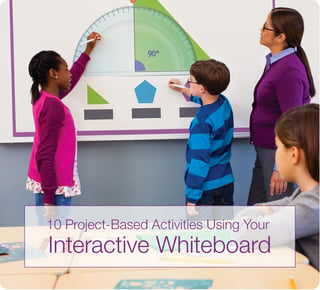Interactive whiteboards and their software shouldn’t be classroom tools you forget
 With all the new technology surrounding us, we tend to forget how many exciting ways we can use our interactive whiteboards with students. Most (if not all) interactive whiteboards come with software that offers a variety of tools for both teachers and students.
With all the new technology surrounding us, we tend to forget how many exciting ways we can use our interactive whiteboards with students. Most (if not all) interactive whiteboards come with software that offers a variety of tools for both teachers and students.
Here are some examples of the ways teachers and students can use the software for engaging projects:
- Find video clips that mention vocabulary related to science or social studies units you are studying. Embed the clips in your whiteboard software. Encourage study breaks and have students match the vocabulary word to the video clip at the front of the room on the IWB.
- Use the interactive whiteboard software to make a “Choose Your Own Adventure” story. Hyperlinks can send students to their next adventure. Leave the story unfinished and encourage students to create their own ending. Send students on their own “Choose Your Own Adventure” story.
- Plan a “Mystery Skype Geography Guess the State” meeting with another school across the country. Use the interactive whiteboard software with students to create an engaging presentation about your state for your partner class. Let students be creative and work together on individual pages.
- Use the interactive whiteboard software’s built-in screen-recording option to create math tutorials on topics students might be struggling with. Encourage students to work in groups and create their own tutorials. Remind students to use images to tell a story that can go along with their math problem. For example, have students work in groups to solve elapsed-time word problems. Each group can use props and tools to solve their problem while telling a story. At the end, share with the class using the interactive whiteboard.
- Have students create backdrops from the software to include in a news broadcast they would do for their class on a current event. Students could include images and text in their backdrops to enhance their broadcast. Then each student can deliver his or her broadcast to the class using the IWB.
- Use the Line and Shapes features of the software to have students create graphic organizers, infographics, and other charts for activities such as research projects, food-web explanations, planning a story, and more. Images, video, and links to websites can also be added.
- Set up your software as a center for categorization activities that use the Screen Clipping and Copy/Paste tools. Each student gets his or her own page to create. For example, have students show all the ways to represent a fraction, categorize animals that are carnivores, present various ways to make change from $5 as part of a math word problem, provide examples of animal adaptation, or name states within a specific region of the country.
- Promote reading in the classroom by having students create book trailers using the whiteboard software. Each page of their book trailer could be saved as an image and placed into Animoto or Wevideo to create an engaging video trailer. Share the videos with the class and library media center.
- Integrate other software into your whiteboard software. Create a Google Earth literature trip and attach it to your whiteboard lesson or activity. Link to a Google Form to use as a student assessment tool directly from the lesson taught.
- Use the software in conjunction with a sound recording program such as Audacity. Have students answer questions aloud about an informative text article, and embed the recording in the interactive whiteboard software. Play each student’s answers as a class for further discussion. In addition, the sound recording program could be used to support a class debate about a current events topic, with the recordings embedded into separate whiteboard pages.
Try it out for yourself
If you like these ideas but don’t already have your own IWB and classroom software, try Mimio’s software. You can download a free lite version to create lessons and activities. Try it free today! >>



